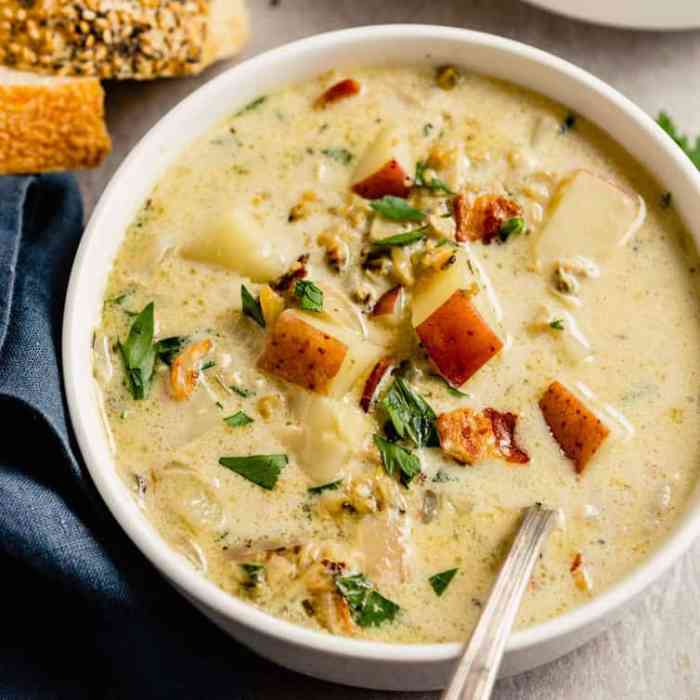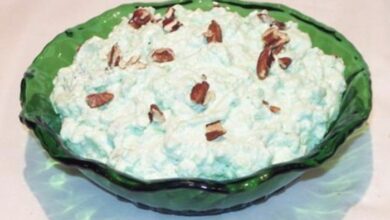
New England Style Clam Chowder: A Culinary Classic
New England style clam chowder is a beloved dish that embodies the spirit of New England cuisine. This creamy, comforting soup has a rich history, dating back to the early days of colonial America. Its origins are intertwined with the region’s maritime heritage, with fishermen and settlers alike relying on the bounty of the Atlantic Ocean for sustenance.
Clam chowder quickly became a staple of New England dining, enjoyed by families and celebrated at local gatherings. Over time, the recipe has evolved, with variations emerging across different regions of New England. Today, New England clam chowder remains a cherished tradition, a testament to the enduring appeal of this simple yet flavorful soup.
The heart of New England clam chowder lies in its ingredients. Fresh, plump clams are the star of the show, their briny flavor adding depth and complexity to the soup. Milk, often combined with cream, provides a rich, creamy texture, while potatoes add a hearty element and onions lend a touch of sweetness.
The soup is traditionally thickened with a roux, a mixture of butter and flour, creating a smooth and velvety consistency. While the basic recipe remains consistent, variations exist, with some cooks incorporating other vegetables like celery or carrots, while others prefer to add a splash of white wine or a pinch of herbs.
The beauty of New England clam chowder lies in its adaptability, allowing each cook to personalize the dish with their own unique touch.
History of New England Clam Chowder
New England clam chowder, a beloved culinary icon, boasts a rich history that intertwines with the maritime heritage and culinary traditions of the region. Its origins can be traced back to the early days of European settlement in New England, where the abundance of clams and the need for hearty, filling meals led to the creation of this iconic dish.
The Origins of New England Clam Chowder
The earliest iterations of clam chowder were likely simple stews, combining fresh clams with ingredients readily available to early settlers. These ingredients included salted pork, onions, and sometimes potatoes, creating a thick and flavorful broth. While the exact origins remain shrouded in the mists of time, historical records and anecdotal accounts suggest that clam chowder was already a popular dish in New England by the 18th century.
The Evolution of the Recipe
Over time, the recipe for clam chowder evolved, incorporating new ingredients and techniques. The addition of milk or cream, a staple in European cuisine, transformed the chowder into a smoother, richer dish. The use of tomatoes, introduced to the region in the 19th century, also became a popular variation, giving rise to the distinct Manhattan clam chowder.
However, the traditional New England clam chowder remained a favorite, characterized by its creamy consistency, delicate clam flavor, and simple, yet satisfying, ingredients.
The Role of Clam Chowder in New England Culture
Clam chowder has become an integral part of New England culture and cuisine, a symbol of the region’s maritime heritage and culinary traditions. It is a dish that evokes a sense of place, reminding people of cozy evenings by the fireplace, seaside picnics, and the bounty of the Atlantic Ocean.
Clam chowder is also deeply ingrained in New England’s social fabric, a dish that brings families and friends together around the table, fostering a sense of community and shared culinary experiences.
Notable Moments in the History of Clam Chowder
- 18th Century:Early iterations of clam chowder, likely simple stews, emerge as a popular dish in New England.
- 19th Century:The addition of milk or cream transforms the chowder into a smoother, richer dish. Tomatoes are introduced to the region, leading to the development of Manhattan clam chowder.
- 20th Century:Clam chowder gains widespread popularity, becoming a staple dish in New England restaurants and homes. It is also featured in various cookbooks and culinary publications, further solidifying its status as a regional icon.
- 21st Century:Clam chowder continues to be enjoyed and celebrated throughout New England, with chefs and home cooks alike putting their own unique twists on the classic recipe.
Ingredients and Preparation
New England clam chowder is a classic American dish that embodies the flavors of the New England coast. Its rich and creamy texture, combined with the briny sweetness of clams, has made it a beloved comfort food for generations. The key to a truly authentic New England clam chowder lies in its simple yet essential ingredients and the meticulous preparation process.The foundation of this iconic dish is a robust broth made from fresh clams, milk, and butter.
These ingredients, when combined, create a harmonious symphony of flavors that encapsulate the essence of New England clam chowder.
Ingredients
The traditional ingredients for New England clam chowder are relatively straightforward, allowing the flavors of the clams and the broth to shine. Here’s a typical ingredient list:
- Fresh clams: The cornerstone of New England clam chowder, fresh clams provide the dish with its signature briny flavor.
- Milk: Milk contributes to the creamy texture and richness of the chowder. It also helps to balance the saltiness of the clams.
- Butter: Butter adds a richness and depth of flavor to the chowder, enhancing the overall taste profile.
- Potatoes: Potatoes provide a hearty base for the chowder, adding substance and texture.
- Onions: Onions add a subtle sweetness and complexity to the flavor profile of the chowder.
- Salt and pepper: Salt and pepper are essential seasonings that enhance the natural flavors of the ingredients.
- Optional ingredients: Some variations of New England clam chowder may include additional ingredients such as celery, thyme, or bay leaves, to add further depth and complexity to the flavor.
Preparation
The preparation of New England clam chowder involves a series of steps that ensure the final dish is both flavorful and visually appealing. Here’s a detailed guide to preparing this iconic dish:
- Prepare the clams: Begin by rinsing the clams thoroughly under cold water to remove any sand or debris. Then, place the clams in a large pot with a few inches of cold water and allow them to sit for about 30 minutes. This will help the clams to purge any remaining sand or grit.
- Make the clam broth: After the clams have purged, bring the pot to a boil over high heat. Cover the pot and reduce the heat to medium. Cook the clams for about 5-7 minutes, or until they have opened. Remove the clams from the pot and set aside. Strain the clam broth through a fine-mesh sieve and discard any remaining solids.
- Sauté the vegetables: While the clams are cooking, melt the butter in a large pot over medium heat. Add the onions and cook until softened, about 5 minutes. Add the potatoes and cook for an additional 5 minutes, or until they are slightly softened.
- Add the milk and clam broth: Pour the milk and clam broth into the pot with the vegetables. Bring the mixture to a simmer over medium heat. Reduce the heat to low and simmer for about 15 minutes, or until the potatoes are tender.
- Add the clams: Add the cooked clams to the pot and stir gently to combine. Simmer for an additional 5 minutes, or until the clams are heated through. Season the chowder with salt and pepper to taste.
- Serve: Ladle the chowder into bowls and serve immediately. Garnish with chopped parsley, if desired.
Types of Clams
The choice of clams can significantly impact the flavor profile of New England clam chowder. Here’s a comparison of different types of clams commonly used in this dish:
- Quahog clams: These clams are a popular choice for New England clam chowder, as they offer a sweet and briny flavor that is well-balanced. They are also relatively large, providing a substantial texture to the chowder.
- Cherrystone clams: Cherrystone clams are smaller than quahogs and have a milder, more delicate flavor. They are often used in clam chowder when a less intense flavor is desired.
- Littleneck clams: Littleneck clams are the smallest of the three types mentioned, and they have a very delicate flavor. They are often used in clam chowder when a subtle and refined flavor is desired.
Variations and Regional Differences
New England clam chowder, while rooted in tradition, has evolved into a dish with numerous variations, each reflecting regional preferences and culinary creativity. These variations extend beyond the use of different thickening agents and seasonings, encompassing unique ingredients, preparation methods, and even the type of clam used.
Thickening Agents and Seasonings
The choice of thickening agent significantly impacts the texture and mouthfeel of New England clam chowder. While flour is the most common, other options include:
- Potato Starch:Offers a smoother, silkier texture compared to flour.
- Cornstarch:Provides a slightly thicker consistency than flour, often used in combination with flour.
- Roux:A mixture of butter and flour, creating a richer flavor and a thicker, more velvety texture.
Beyond thickening agents, seasonings play a crucial role in shaping the flavor profile of the chowder. Common additions include:
- Salt and Pepper:Essential for enhancing the natural flavors of the clams and other ingredients.
- Bay Leaf:Adds a subtle, earthy aroma and depth of flavor.
- Thyme:Provides a fresh, herbaceous note, complementing the clam and potato flavors.
- Parsley:Offers a bright, green flavor and visual appeal, often added at the end of cooking.
Regional Variations
New England clam chowder exhibits distinct regional variations, each reflecting local traditions and culinary preferences.
- Maine:Often features a higher concentration of clams, resulting in a more intense clam flavor. Some versions may also include a dash of sherry or white wine for added complexity.
- Rhode Island:Known for its use of quahogs, a type of clam native to the region, contributing a slightly sweeter and more briny flavor.
- Massachusetts:Typically uses a combination of clams and potatoes, resulting in a heartier and more filling chowder. Some recipes may also include diced celery or onions for added texture and flavor.
Comparison with Other Regional Styles
New England clam chowder stands in stark contrast to other regional styles, particularly Manhattan clam chowder. While New England clam chowder is a creamy, white-based soup, Manhattan clam chowder is a tomato-based broth, typically made with chopped clams and often served with oyster crackers.
“New England clam chowder is a creamy, white-based soup, while Manhattan clam chowder is a tomato-based broth.”
Both styles have their own unique flavors and textures, reflecting the diverse culinary traditions of the United States.
Serving and Accompaniments: New England Style Clam Chowder

New England clam chowder, a hearty and flavorful soup, is traditionally served in a bowl, often with a dollop of heavy cream or a sprinkle of fresh parsley for garnish. The soup’s rich texture and creamy consistency make it a comforting meal, particularly during colder months.
Serving Suggestions
Serving suggestions for New England clam chowder can vary depending on the occasion and personal preference. Here’s a table outlining various serving suggestions:
| Category | Suggestions |
|---|---|
| Appetizers |
|
| Main Courses |
|
| Side Dishes |
|
Cultural Significance
New England clam chowder holds a special place in the cultural landscape of New England, particularly in coastal communities. It’s often served at family gatherings, potlucks, and local festivals, symbolizing the region’s rich culinary heritage. The soup’s association with these events strengthens the sense of community and tradition.
For instance, the annual Chowderfest in Rhode Island, a popular event showcasing various clam chowder recipes, attracts thousands of visitors and exemplifies the cultural significance of this beloved dish.
Cultural Significance
New England clam chowder is more than just a delicious soup; it’s deeply intertwined with the region’s culture and identity. It’s a dish that embodies the spirit of New England, reflecting its history, traditions, and way of life. From its humble beginnings as a hearty meal for fishermen to its iconic status in New England cuisine, clam chowder has played a significant role in shaping the region’s culinary landscape and its collective memory.
Clam Chowder in New England Literature and Art
Clam chowder’s prominence in New England culture is evident in its frequent appearances in literature and art. It’s a dish that has inspired writers and artists to capture the essence of New England life and its unique flavors.
- Literary Representations:Authors like Nathaniel Hawthorne, Henry David Thoreau, and Louisa May Alcott have incorporated clam chowder into their narratives, often using it as a symbol of New England simplicity, hospitality, and community. For example, in Louisa May Alcott’s -Little Women*, the March sisters enjoy a bowl of clam chowder during a cozy family gathering, highlighting the comfort and warmth associated with the dish.
- Artistic Depictions:Clam chowder has also found its way into paintings and illustrations, often serving as a centerpiece in scenes depicting New England life. These artistic representations capture the essence of the dish, its ingredients, and its connection to the region’s culinary heritage.
Clam Chowder in Popular Culture, New england style clam chowder
Beyond literature and art, clam chowder has also become a staple in popular culture, further solidifying its place in New England’s identity.
- Festivals and Events:Numerous festivals and events across New England celebrate clam chowder, showcasing its regional significance and drawing crowds of food enthusiasts. The annual Clam Chowder Festival in Rhode Island, for instance, attracts thousands of visitors who come to sample various chowder recipes and participate in the festivities.
- Media Representations:Clam chowder has been featured in movies, TV shows, and commercials, often used to depict New England charm and its culinary traditions. The dish’s popularity has made it a recognizable symbol of the region, appearing in everything from local news segments to national advertising campaigns.






